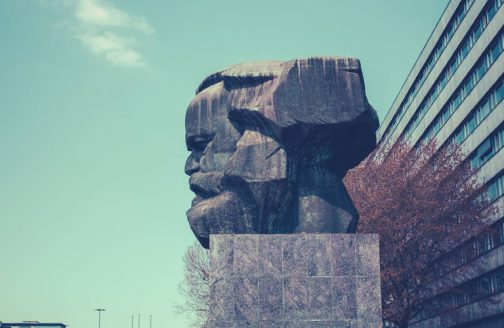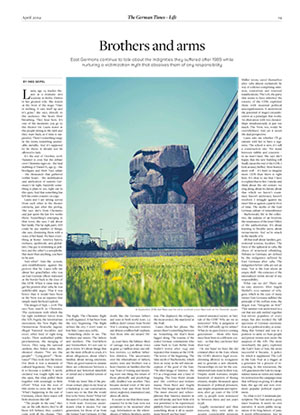East Germans continue to talk about the indignities they suffered after 1989 while nurturing a victimization myth that absolves them of any responsibility

Laura, age 19, studies theater at a dramatic arts academy in Berlin. Elektra is her greatest role. She stands at the front of the stage: “Hate is nothing. It eats itself up and it’s gone,” she says, directly to the audience. She hears their breathing. They hear hers. It’s one of the moments you go to the theater for. Laura stares at the people sitting in the dark and they stare back, as if time is suspended. There’s something tangy in the room, something undeniable, metallic. And it’s supposed to be there; it should not be allowed to fade.
It’s the end of October, 2018. Summer is over, but the debate over Chemnitz rages on – the fatal stabbing of Daniel H., age 35 – the hooligans and their Nazi salute – the thousands that gathered within hours – the mobilization and unification of eastern Germany’s far right. Suddenly something is plain to see, right out in the open. And that something has left the entire country on edge.
Laura and I are sitting across from each other in the theater cafeteria, just after the prolog. She says she’s from Chemnitz and just spent the last few weeks there. Something’s emerging in that town, she says. I ask about her family. The far-right party AfD could be any number of things, she says, dismissing them with a wave of her hand. We have everything at home: America haters, recluses, apoliticals, anti-globalists. One guy is swimming in politics, and the other’s a xenophobe. But more than anything, you have to be anti.
Anti-what? Anti-the system, anti-establishment, against the powers that be. Laura tells me about her grandfather, who was an East German officer stationed at the border back in the days of the GDR. When it came time to get his pension after 1989, he was unbelievably angry. That it was lower than it would have been in the West was an injustice that simply made his head explode.
The images of Sept. 1, 2018. The neo-Nazi march in Chemnitz. The excitement with which the far right mobilized forces from the AfD, Pegida, the Identitartian movement, the New Right, the Heimattreue Deutsche Jugend, illegal National Socialists and every other kind of right-wing wacko. Their unabashed public proclamation, the merging of forces. They sang the national anthem, they linked arms, they shouted chants: “We are the people!” – “Lying press!” – “Resistance!” They took over the street. For them it was a moment of cultural hegemony. They wanted it to become a symbol. A newly declared war, fought right out in the open. But what pulled them together with seemingly so little effort? What was the root of this desire to cross the red line? What’s happening in the east of Germany, where three states will hold elections this fall?
“The people in the east,” they say on the talk shows, they’ve all been left behind, they couldn’t cope with all the change. They complain about lower pay than in the west, and lower pensions. They’re afraid that all the refugees will be taking over the homes organic Germans. We hear their worries, but something tells us that something deeper is feeding their wrath, something unspoken, something elusive, something unsettling. What is it?
Laura swirls her cup of latte in her hands and speaks of her brother, who actually has a good job, but who’s also been a part of that scene since the beginning. The Right. The Chemnitz Right is well organized. It has been from the very beginning. The Right defines the city. I don’t want to lose him, Laura says, softly.
Something clicks in me. The brothers and sisters. The fathers and mothers. The forefathers and foremothers. It’s not easy to pin it down. It’s about things that are the most difficult to crack, it’s about allegiances, about what’s familiar, about strong emotions. There are good reasons to assume there are coherencies between a political and historical minefield of denial and a familial system of denial.
While my inner film of the previous century plays in my head as a backdrop to our conversation, Laura says to me that she would love to be Swiss. Swiss? What for? Because it’s a clean slate, she says. A fresh start. Everyone understands what it means. For our generation, for those of us from the former East Germany, it’s like we’re walking through a thick fog, like through a dense forest made of ghosts instead of trees. It’s just too much history. What’s true? What’s a lie? I just can’t find my way out. It’s tough, and it’s exhausting.
That it is, I hear myself say. I actually want to say something different, because the old film has picked up speed in my head. Endless sequences. More like nightmares, of marching, cheering, falling, dying men. Taking an oath and following it, obeying it until death, like the German fathers and sons in both world wars. 2.5 million didn’t return from World War I, creating 600,000 widows and almost a million half-orphans. And those who did return? Difficult.
25 years later, the balance sheet of carnage was just about twice as grim: 4.7 million dead, one million widows, 2.5 million fatherless children. The uncertainty over the whereabouts of fathers, uncles, sons and brothers was a heavy burden on families after the war. Years of waiting and mourning were one thing; the return of those physically and psychologically disabled was another. They became mental voids of the new societies, East and West: bewildered, neglected, traumatized and, above all, silent.
It occurs to me that those unaccounted for in the East were not permitted to be mourned after 1945. Information on the whereabouts of fathers, brothers, uncles and grandfathers could only be had in the West, by petitioning the Red Cross. Hopes for success were slim. All mail was monitored.
What does that do to a society when the wartime fates of millions of men remain unresolved? When do you give up hoping, waiting, asking, thinking, feeling? What to do with – and where to put – the interminable grief? The public denial of countless deaths coupled with the private mourning. It is merely a taboo that made the GDR the land of silence that it was. The displaced, the refugees, the incarcerated, the murdered at the Wall.
Laura checks her phone. She senses there’s something between us. Something old that’s been lugged along. The trauma of the exiled German communists who came back to East Berlin from Stalin’s terror after 1945 and repeated this trauma as the GDR. The terror of the beginning. The false myth of Buchenwald, which lives on today as the self-misconception of the good of the East. The tilted image of America – the US as a bogeyman and a land of longing. The Easy Rider dream and the cowboys-and-indians mania. Dean Reed and Angela Davis, Pete Seeger and Bob Dylan. The inner discord and schizophrenia that America masters in one fell stroke, and how little of it was permitted to be experienced publicly. Does Laura need to know something about it all to understand herself and her time?
I ask whether she was able to speak with her grandfather. Speak? She couldn’t. She didn’t dare. He was too… hard, walled up. She regrets it now. He died five years ago from a ruptured heart.
The difficult process of unsilencing after 1989. What happened with all the tabooed living, with all that went unperceived, with all that was hidden and unheard? Why can we not succeed in differentiating between East Germany as a consensus dictatorship, socialist project, control-saturated society or fairy tale of the GDR? Why are we so indecisive? Why is judgment of the GDR still oddly up for debate? What do we pass down to coming generations – those who have since been born in a different century – so that they can better find their way?
On one hand we have the old criminal elites in the East, whom the GDR’s abortive legal reconditioning allowed to reorganize and to generate a new clientele. Dictatorships do not let the constitutional state stand in their way. Despite death warrants, despite hundreds of murders of fleeing citizens, despite thousands upon thousands of political prisoners, and despite despotism and repression, after 40 years of the GDR only 23 people were sentenced to between three and ten years in jail.
Legally exonerated and thus innocent, they were able to acquire considerable pensions for their “lifetime achievement,” hoisted themselves into honorable posts and political positions, became organized in dubious associations and, conspicuously well-networked, and are back at it in a now unlimited “area of operations.” And moreover, the old elites are now even angling for elevation into history books. They want to be seen as having brought honor to Germany and aspire to a place in the historical sun.
Those “who had settled in the idea,” as the playwright Heiner Mueller wrote, saved themselves after 1989 almost exclusively by way of a silence comprising omission, contortion and renewed inauthenticity. The Left, the party that seems to have inherited the toxicity of the GDR, exploited them with maximal political unscrupulousness. It understood the potential of staged circumlocution as a paradigm that works. An altercation with two dictatorships simultaneously is just too much. The West, too, would be overwhelmed. And yet it needs the dual perspective.
Laura asks me whether I’ll go outside with her to have a cigarette. The school is new; it’s still a construction site. We stand between rubble and concrete – in no-man’s-land. She says she’s happy that the new building will finally mean the end of the GDR. I look around, baffled. More border, more wall – it’s hard to imagine more GDR than there is right here. It’s clear to me that I have to explain that to her. I smoke and think about the old century we drag along, about its dictate, about that which we haven’t examined, haven’t addressed, haven’t resolved. I struggle against my inner film as against a putrid river of time. The myths of the East German culture of remembrance – Buchenwald, life in the collective, the malaise of un-freedom, the renaissance of the inner Hitler, of the authoritarian. It’s about learning to breathe anew, about reenactments. And we’re smack in the middle of it.
All that stuff about families, generational tension, loyalties. The force of the upheaval in 1989, the chaos of structural rebuilding. Debates in Germany are defined by the indignities suffered by East Germans after 1989. The indignities before 1989 are not an issue. Nor is the East idiom an empty shell – the existence of the internalized victim devoid of any responsibility.
What can we do? There are no easy answers. After Angela Merkel’s 2015 summer of refugees, which in the eyes of many former East Germans nullified the principle of the welfare state, the slogan was: “Integrate us first!” That summer was understood as a cut that not only melded together fear-driven populists of every stripe, but also invoked the full spectrum of German emotions. Fear as a political reality, as something that formed and was in a position to unite ex-Stasi people and prison victims now under the auspices of the AfD. The more trenchantly the party exploited the East’s fears of loss, the more successful it became. A policy by which it supplanted The Left in the East. Fear as a trigger, as a generator for a process of reenacting. In this interaction, the AfD guarantees the East its encapsulated status as victim and makes its destruction the campaign issue that will keep on giving. It’s about hate, the age-old and now evermore popular political experiment.
So, what to do? A minimum prescription: The East needs a good, inner location. It needs its own narrative. It needs public recognition of its long history of pain. It needs differentiation. And its experiential force must project outward: into the political realm, into education and, above all, to the dinner table.
Ines Geipel
is a writer and a poetry professor at Berlin’s University of Performing Arts Ernst Busch. Her new book, Umkämpfte Zone. Mein Bruder, der Osten und der Hass (Embattled zone. My brother, the East and hate) has just been published by Klett-Cotta-Verlag (Stuttgart) and has become a top-15 bestseller.




